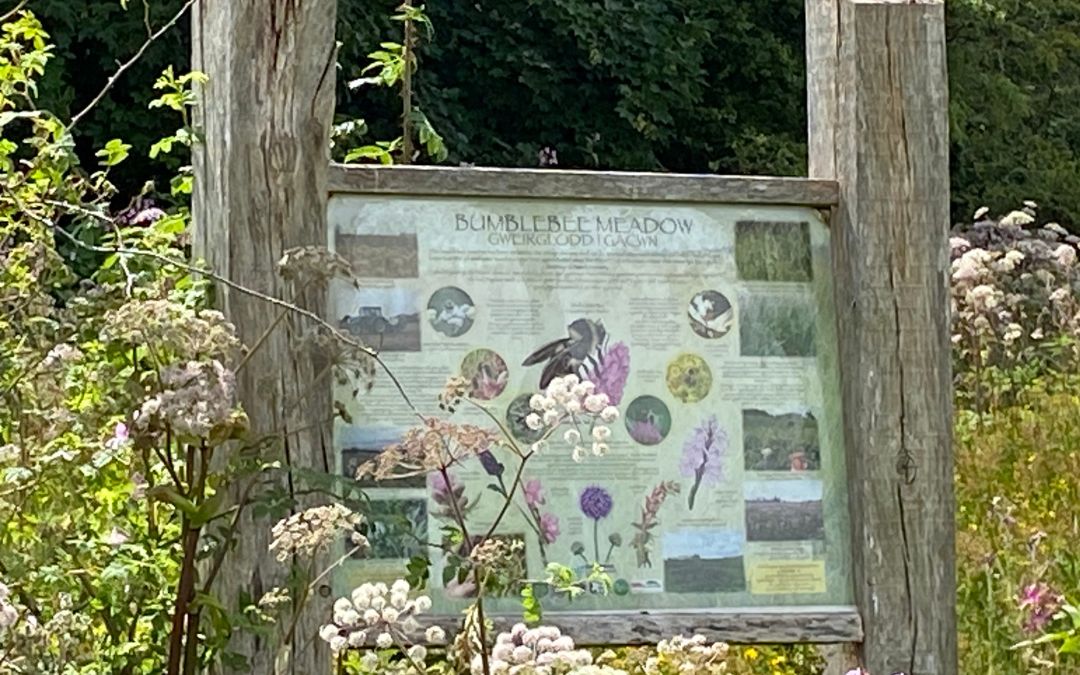Everyone on board to save UK pollinators

In the UK in the last 80 years, lowland meadows which are the prime source of wildflowers for pollinators, have decreased by 97%. In actual terms that is a reduction from 13 million hectares to just 100,000 hectares. Almost too late, people have realised how serious this situation is and all over the country individuals, Councils, Government, Wildlife Trusts, neighbourhood, conservation and environment groups are working to reverse this. It’s a truly collaborative effort!
In many places such as Oxford, where my husband Paul and I began our recent trip, local people are forming nature groups to protect their own neighbourhood. This includes nature walks through meadows led by locals explaining the interactions within ecosystems that are so essential for the survival and health of the system. We were fortunate on our second day off the plane to go on one such walk and hear from local people about what they are doing to protect their pollinators, especially bees, bumblebees, wasps, moths and butterflies, hover flies, beetles and other insect pollinators.
This group was lobbying for nature strips, verges, median strips down the motorways as well as fields to be left un-mown until after all flowering had finished. They were also opposing inappropriate development on meadowland behind their housing estate and had successfully, with good research and well written objections, overcome several development applications. What struck us was the wide array of people coming together on this endeavour, working for the common good, irrespective of their political persuasion.
Throughout England and Wales we frequently noticed signs on verges and median strips saying ‘Pollination Zone’ or ‘No Mow Zone’ or ‘Create a Buzz Pollination Trail’ or more informal notices such as ‘Pardon the weeds we are feeding the bees’. We also noticed fields reserved entirely as pollinator habitat or bumblebee meadows.
The 2012 London Olympics were described as the first sustainable games and part of that was a biodiversity strategy which included Wildflower Turf being planted throughout the Olympic sites. This turf, containing 34 perennial native wildflowers, delivered key biodiversity targets. It is now available commercially and we saw extensive meadows of it at the Weald and Downland Living Museum in the south of England. (This is the home of The Repair Shop and has featured also on Antiques Roadshow).
The English Government in 2014 set out ‘The National Pollinator Strategy: for bees and other pollinators’. The purpose is to protect the A$200 billion dollar food industry which is central to their economy. That the government recognised the need for increased biodiversity, should tell us how important the loss of pollinator habitat and pollinators has been.
Another impressive contributor is the Incredible Edible initiative. This started in one town In North Yorkshire, Todmorden, in 2008 and initiatives now number over 200 in the UK and 1000 around the world e.g. Incredible Edible Eltham. It has even been funded by the Big Lottery Fund to spread its work, so important has its contribution been. Every small town we visited seemed to have 3 or 4 beds devoted to vegetables, herbs and flowers from which anyone could take a fair share and we believe this is often repeated numerous times throughout some towns with plantings in all sorts of places as well – any piece of land that is suitable. The ethos of the Incredible Edible movement is to ‘Ask for forgiveness not permission’ and that citizens have a right to take action to protect their future. One of the founders, Pam Warhurst, calls it ‘Propaganda Gardening’. Teaching people to grow food is another essential way of increasing pollinators which is a key target of the Incredible Edible movement.
Wildflowers are so prevalent in England and Wales that you would be forgiven for thinking that there is no problem at all and yet the problem is of profound proportions. This is something we need to take on here.
We can begin by recognising which insects are pollinators, understand the complex dependence between specific plants and their pollinators, understand that it is the volume of land available to pollinators that counts and that the need to protect and increase biodiversity for our pollinators is vital. In the short term, plant as many flowers and flowering shrubs as you can and do this seasonally so that food is available year round and especially through winter.
References:
Oxford Zero Carbon summit, charter and partnership
London Pathway to Net Zero Carbon by 2030
National pollinator strategy: for bees and other pollinators
Royal Horticultural Society, Pollinators: Decline in numbers
Written by Robin Gale-Baker
